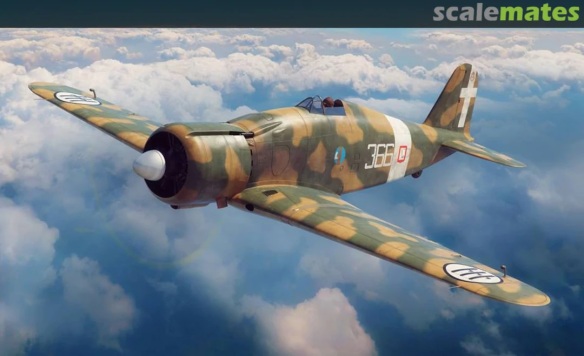
The Fiat G.50 was built in response to specifications issued by the Ministerio dell’ Aeronautica in 1936, calling for a lightly armed interceptor, a long-range escort fighter, and a fighter-bomber. While other manufacturers submitted four designs to address each of those requirements, Fiat’s Giuseppe Gabrielli designed his G.50 to satisfy all three. Built around the new 840-horsepower Fiat A.74 twin-row fourteen-cylinder radial engine, the G.50, which first flew on February 26, 1937, became the first Italian monoplane fighter to enter production, with an initial order for forty-five machines. After the second prototype crashed in September, the G.50’s competitor, the Macchi C.200, was judged the better fighter, but G.50 production continued as insurance against any problems in getting the C.200 into operation.
During a visit to Italy, García Morato test-flew a G.50 at Guidonia in October 1937. He then returned to the Catrulla Azul and his trusy CR.32, in which he brought his tally to forty on January 19, 1939. On April 4, days after the Nationalist victory, Spain’s ace of aces performed aerial stunts for the newsreel cameras at Griñón. While flying inverted at low altitude, his Fiat’s engine suddenly cut out and Morato crashed to his death.
The first G.50s entered Regia Aeronautica service at the end of 1938, and ten were promptly shipped to Spain, where they were formed into a Gruppo Sperimentale de Caccia (Experimental Fighter Group) under the command of Maggiore (Major) Mario Bonzano. The unit was based at Escalona alongside the CR.32s of Bonzano’s old unit, the XXIII Gruppo, and consequently some of the G.50s were marked with that group’s “Asso di Bastoni” (Ace of Spades) emblem. Flying as escort to the CR.32s at an altitude of 8,000 meters, the G.50s saw some service in the last fortnight of the war but encountered no aerial opposition. The principal operational evaluation consisted of pilot complaints about inadequate visibility from the enclosed cockpit, which resulted in the adoption of a traditional open cockpit for all subsequent production batches of the G.50.
Even after World War II broke out, the Regia Aeronautica was remarkably reticent about committing its Fiat G.50s to combat. During the Battle of Britain, for example, the 20o Gruppo’s G.50s only flew discrete patrols over the English Channel, while the 18o Gruppo’s CR.42 biplanes escorted Fiat BR.20 bombers over Britain in November 1940—with predictably disastrous results when they encountered Hurricanes and Spitfires. By that time, however, another country had been less shy about blooding the G.50 in combat.
After the Soviet Union attacked Finland on November 30, 1939, Italy—which unlike Germany had not signed a nonaggression pact with Stalin—shipped some of its G.50s to the beleaguered Finns. The first Fiats were organized into a Koelentue (Test Flight) under Kapteeni (Captain) Erkki Olavi Ehrnrooth, and were soon “tested” in battle. On January 13, 1940, Ehrnrooth, appropriately flying a Fiat bearing the serial number FA-1, shot down an SB-2 bomber over Sisä-Suomi, followed by an Ilyushin DB-3 on January 29.
By February, G.50s were actively serving in a regular squadron, Lentolaivue 26, which added a number of additional Soviet aircraft to the butcher bill before Finland finally capitulated on March 13, 1940. On February 26, a Spanish Civil War match—which had not, up till that time, occurred—was finally achieved when Luutnantti (Lieutenant) Risto Olli Petter Puhakka, in Fiat FA-4, took on an I-16 and shot it down over Etelä-Suomi for his fifth victory (he had scored four earlier in Fokker D. XXIs). On February 29, Vääpeli (Sergeant Major) Lasse Erik Aaltonen, also flying FA-4, downed a DB-3, followed by an I-153 on March 2. Two days before the armistice Puhakka, in FA-21, destroyed a DB-3. The Finnish Fiats would serve on in the Continuation War as well, with considerably more distinction than they achieved in Regia Aeronautica service. Puhakka would score another eleven victories in G.50s before going on to Me 109Gs and finishing out the war as Finland’s sixth-ranking ace with a final tally of forty-two, while Aaltonen’s tally would total at least a dozen.
Variants
G.50
First production version.
G.50 bis
Development of the G.50 version with extended range; 421 built.
G.50 bis/A
Two seat carrier fighter modified from a G.50B; one modified.
G.50 ter
More powerful version with a 746 kW (1,000 hp) Fiat A.76 engine; one built.
G.50V
Liquid-cooled V12 variant with a Daimler-Benz DB 601 engine; one built.
G.50 bis A/N
Two-seat fighter-bomber prototype; one built.
G.50B
Two-seat trainer version. 100 aircraft built.
G.51
Projected production version of the G.50V, abandoned in favour of the Fiat G.55.
G.52
Projected version of the G.50, powered by a Fiat A.75 R.C.53 engine. The engine never materialised and the G.52 was never built.
Specifications (G.50)
General characteristics
Crew: 1
Length: 8.01 m (26 ft 3 in)
Wingspan: 10.99 m (36 ft 1 in)
Height: 3.28 m (10 ft 9 in)
Wing area: 18.25 m2 (196.4 sq ft)
Empty weight: 1,963 kg (4,328 lb)
Max takeoff weight: 2,402 kg (5,296 lb)
Powerplant: × Fiat A.74 R.C.38 14-cylinder air-cooled radial piston engine, 649 kW (870 hp) for take off
720 kW (966 hp) at 3,800 m (12,467 ft)
Propellers: 3-bladed Hamilton Standard-Fiat constant-speed propeller
Performance
Maximum speed: 470 km/h (290 mph, 250 kn) at 5,000 m (16,404 ft)
Range: 445 km (277 mi, 240 nmi)
Service ceiling: 10,700 m (35,100 ft)
Time to altitude: 5,000 m (16,404 ft) in 6 minutes 3 seconds
Armament
Guns: 2 × 12.7 mm (0.50 in) Breda-SAFAT machine guns